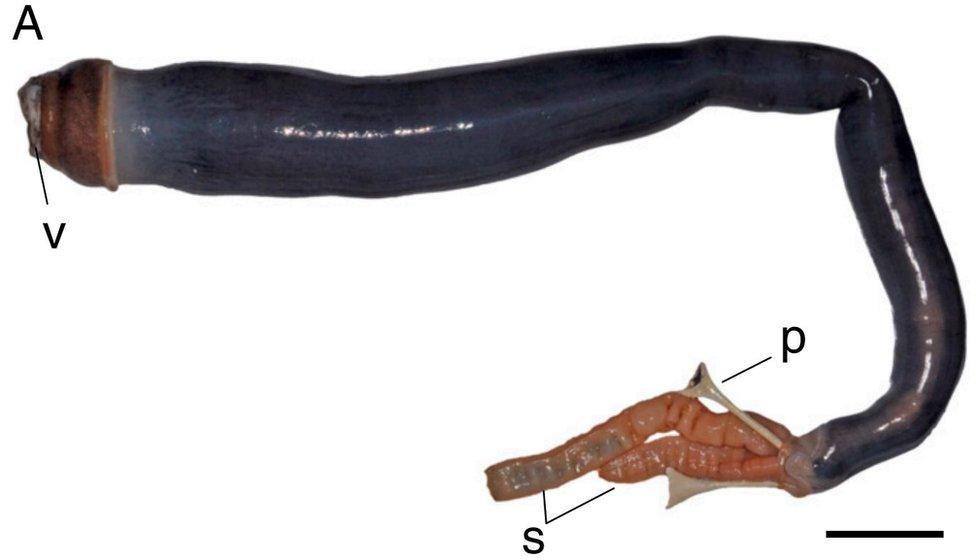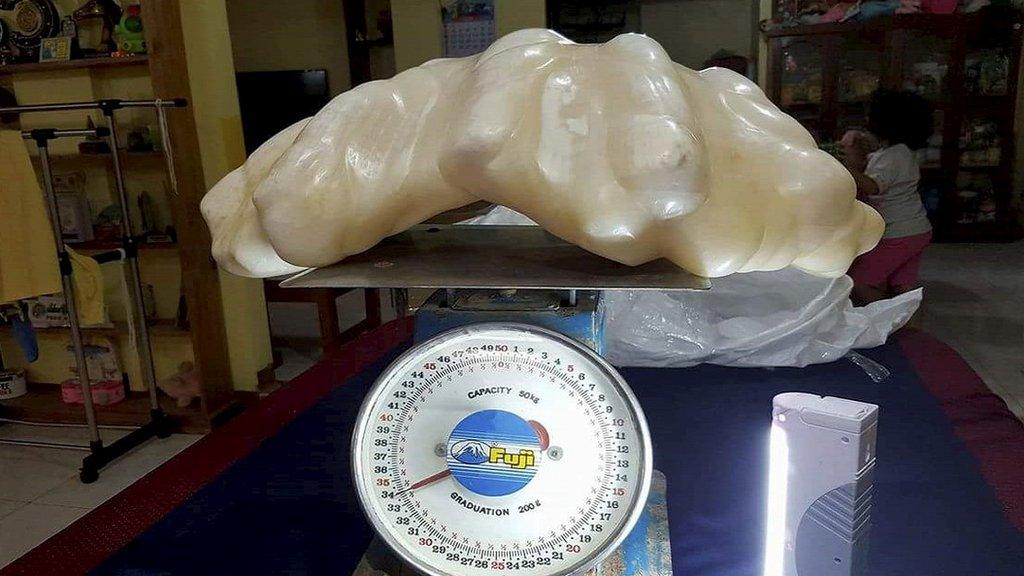Live, long and black giant shipworm found in Philippines
- Published
Living giant shipworm found for the first time in Philippines
Scientists have found live specimens of the rare giant shipworm for the first time, in the Philippines.
Details of the creature, which can reach up to 1.55m (5ft) in length and 6cm (2.3in) in diameter, were published in a US science journal.
The giant shipworm spends its life encased in a hard shell, submerged head-down in mud.
Though its existence has been known for years, no living specimen had been studied until now.
Despite its name, the giant shipworm is actually a bivalve - the same group as clams and mussels.
The "rare and enigmatic species", also known as Kuphus polythamia, is the longest living bivalve known to man, according to the study, external published in the Proceedings of the National Academy of Sciences of the United States of America (PNAS).
The strange shells have been found for centuries, because they are "very sturdy and they last a long time", said Daniel Distel, the report's chief author. "But we've never known where to find them."
The discovery came about by chance, when Dr Distel's team was working in the Philippines with local scientists.
"One of our students came in and said, 'Hey, look at this' - he'd found this really great video on YouTube," Dr Distel said.
"We searched the literature and the scientific sources for years, and then we find it on YouTube. It's the miracle of social media."
That news report, external by Philippines channel GMA Network led a team of scientists from the US, the Philippines and France to find and collect five giant shipworms in Mindanao in a marine bay.
For Dr Distel, who works at Ocean Genome Legacy - a research group and "gene bank", storing the genetic material of rare ocean creatures - it was a major find.
But the scientists are keeping the exact location secret.

The giant shipworm feeds from a valve (marked V) and has two siphons at its tail (marked S) to take in and expel water
The giant shipworms were once found all over the globe, but the team does not know how many are left. On top of that, the outside tubes "fetch a pretty good price" among shell collectors, so the researchers are being careful.
A video shows the scientists cutting off one end of a shipworm's shell, before gently shaking it out. A long, slimy black creature is seen sliding out of the tube-like shell.
"It was like opening a soft-boiled egg - I just tapped on it very, very lightly with a chisel, made a circle, and the shell came off, just like an egg," Dr Distel said.
"It feels a lot like it looks - it's kind of slimy, but it wasn't objectionable, it didn't smell bad."
The team was, however, surprised by its jet-black colour - most bivalves are light cream colours. It is also extremely muscular - or "beefy" - despite the fact that it lives its life in a shell.
Previously, the best information they had was based off drawings of a poorly-preserved dead specimen from the 1960s.


The creature belongs to the shipworm family, whose members are usually much smaller. They burrow into and feed on rotting wood.
The giant shipworm is unique not just for its size, but also for feeding on nutrients in mud and marine sediment instead, using a type of bacteria.
It therefore has a much smaller digestive system compared to other shipworms.
And while the discovery of the animal itself is exciting, the team's research has revealed there is an entire hidden ecosystem at play.
The giant shipworm has bacteria that live inside its shell, converting chemicals from the nearby rotting wood into energy and nutrients, similar to what plants do with sunlight.
That, Dr Distel said, will be a big part of their future research on these rare specimens.
- Published18 April 2017

- Published24 August 2016
